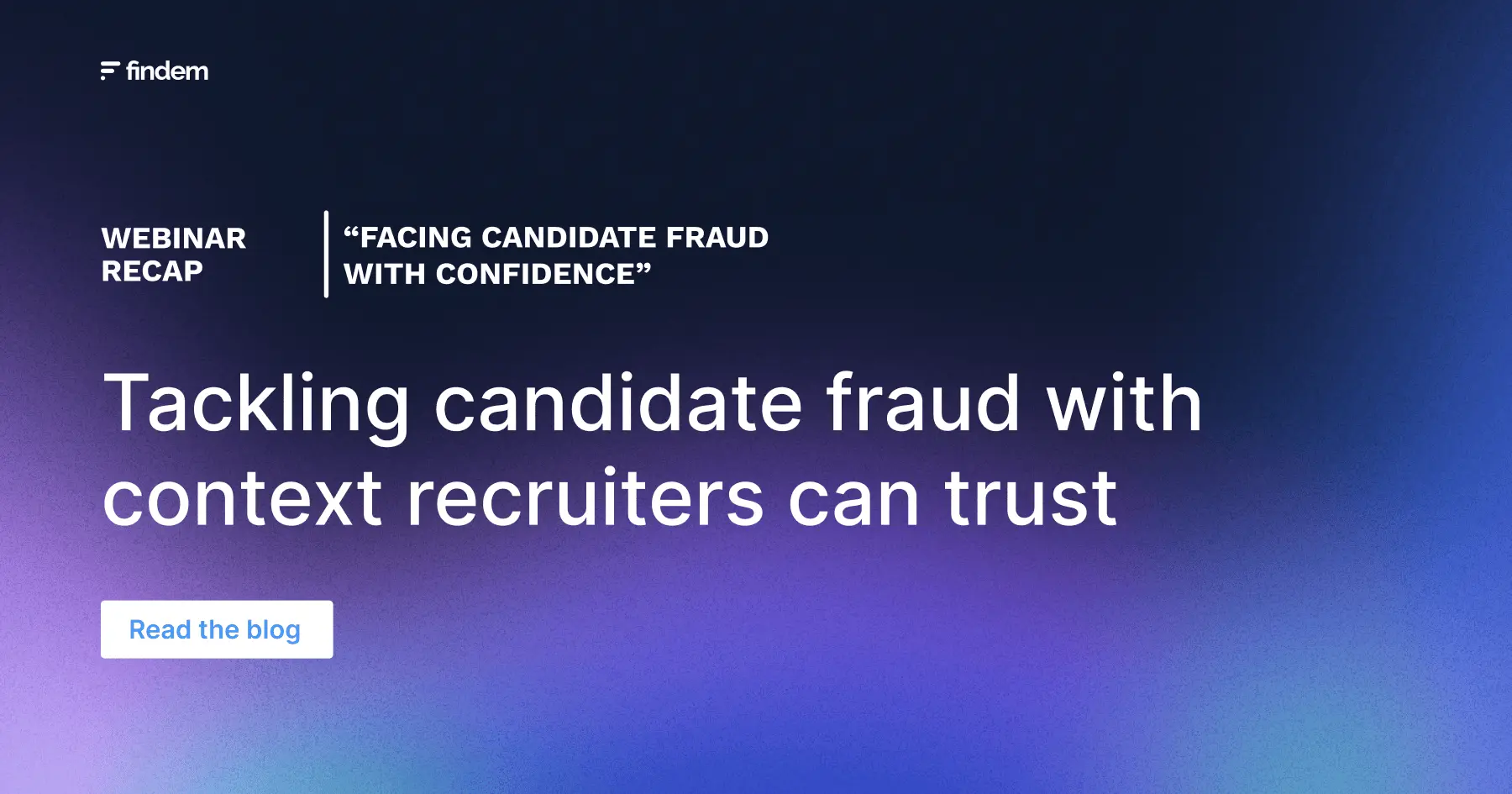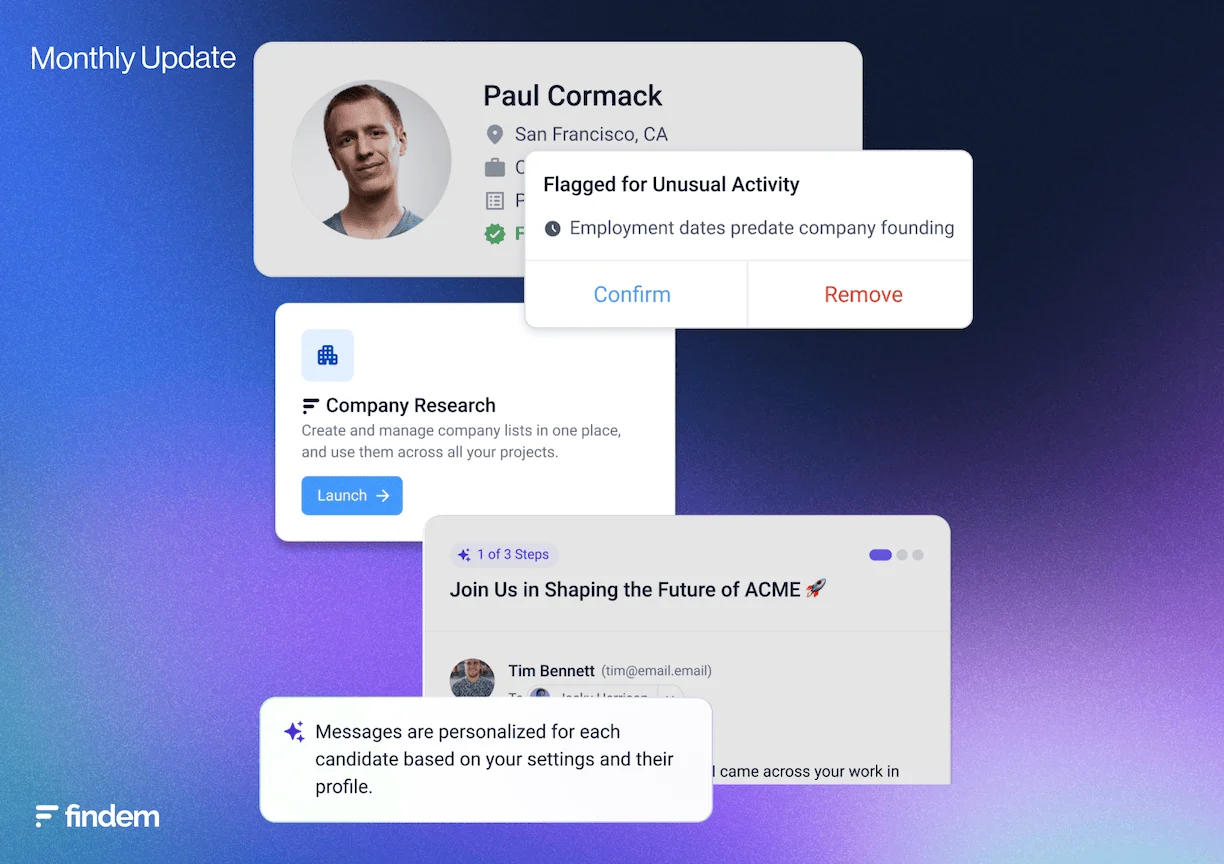.svg)
Tackling candidate fraud with context recruiters can trust
.svg)

.svg)
Candidate fraud used to sit at the edges of talent acquisition. That’s no longer the case. Today, teams see inconsistencies every week — sometimes every day — across inbound pipelines. Gartner expects one in four candidate profiles to be fraudulent by 2028, and many TA leaders say the shift is already happening.
This was the focus of our recent session with Kyle Lagunas, Founder of Kyle & Co, and Ash Ahluwalia, Findem’s Chief Product Officer. The conversation centered on what’s driving the rise in fraud, how teams should respond, and why verification has to move earlier in the process.
The shift has been faster than anyone expected
Kyle opened with an honest reflection: “In Spring 2024, Brian Sommer flagged the imminent wave of fraud that GenAI would unleash in talent acquisition, and I dismissed it out of hand.”
Generative AI didn’t just accelerate embellishment. It industrialized it. What used to be a padded bullet point now appears as a fully rewritten resume that looks polished, coherent, and plausible.
Teams are now dealing with three overlapping challenges.
AI-amplified manipulation
Resumes are being reconstructed with details that don’t match a candidate’s digital footprint, tenure, employers, or identity. The surface looks slicker than ever while the underlying experience becomes harder to validate.
Synthetic and misrepresented profiles
Ash noted that some customers see 30–40% of inbound applicants showing signals that deserve a second look: newly created profiles, unverifiable employers, or timelines that conflict with public information.
Manual verification can’t keep up
Recruiters are spending hours confirming basic facts like employment dates or company existence. Ash summed up their experience, sharing, “Candidate fraud is accelerating, from padded resumes to identity misuse, and it’s hitting recruiting teams where it hurts: time, trust, and compliance.”
For high-volume teams, even small verification tasks add up quickly.
Why most tools today fall short
Most fraud detection tools weren’t built for recruiting. They look at narrow signals, flag candidates late in the process, and often provide little insight into why something was flagged. That lack of clarity creates a new kind of friction.
Kyle summarized the issue for viewers: “Black-box fraud models create trust issues. If recruiters can’t see why something was flagged, they can’t defend the decision.”
During the session, attendees echoed concerns about false positives, lost candidates, and automation that makes bias harder to detect in the chat. Protection matters, but not at the cost of transparency or fairness.
The path forward: Early, explainable verification
Fraud isn’t solved by isolated anomaly detection. It’s solved by understanding people in context: who they are, where they’ve worked, and whether their story aligns across data sources. Ash outlined four principles that define a modern verification model.
- Verify early: Surface inconsistencies as soon as a candidate enters your system, not after interviews begin.
- Explain every signal: If an email domain looks off, if a company doesn't exist in public registries, or if timelines conflict, recruiters need clear reasoning they can trace to the source.
- Keep humans in control: Automation should streamline work, not remove judgment. As Ash explained, "Authenticity Suite provides automatic verification of people, companies, and experiences, with humans in the drivers' seat."
- Support high-volume decision making: Bulk review, suppression of known inauthentic profiles, and focused filters help teams maintain speed without sacrificing quality.
Why 3D data changes what’s possible
Fraud becomes harder to detect when systems only see one dimension: the resume. Claims are easy to fabricate when nothing is checked against a broader context.
Findem’s 3D data — the combination of people, company, and time-ordered data — creates a multi-dimensional view of a career. By drawing from 100,000+ sources, it aligns work history, company context, digital presence, verified patterns of experience, and time-based signals. When the pieces don’t match, it becomes clear immediately.
Examples from the webinar:
- A candidate claims 20 years of experience, but their digital footprint only goes back a few months.
- A listed employer doesn’t appear in business registries.
- Employment dates conflict with publicly documented events like product launches or funding rounds.
These inconsistencies can’t be uncovered through resume parsing alone, and point tools that rely on narrow data sources miss the broader context entirely.
Kyle called out this depth directly: “One solution that has stood out is Findem’s Authenticity Suite, which analyzes several dimensions of candidate profiles and applicant data to help hiring teams determine who’s real and who may not be.”
Verification becomes stronger — and more fair — when it’s grounded in evidence recruiters can see.
What this means for TA teams right now
Fraud is reshaping inbound pipelines across industries. As AI becomes more accessible, distinguishing real candidates from synthetic or misrepresented ones will become an essential part of operational excellence.
Key takeaways from the conversation
- Fraud is rising quickly, and the line between “polished” and “misleading” is getting thinner.
- Verification must move earlier in the process, with full visibility into why something was flagged.
- Context matters more than ever. AI must see more than a resume to be trustworthy.
- 3D data exposes inconsistencies across people, companies, and timelines.
- Findem’s Authenticity Suite brings these Signals together in one workflow, giving teams speed and confidence.
- Recruiters want to spend time with real people. Context-driven verification helps them get there.
Watch the full webinar
Catch the full conversation with Kyle and Ash to hear every example, signal, and bit of practical guidance on strengthening verification across the hiring process.










